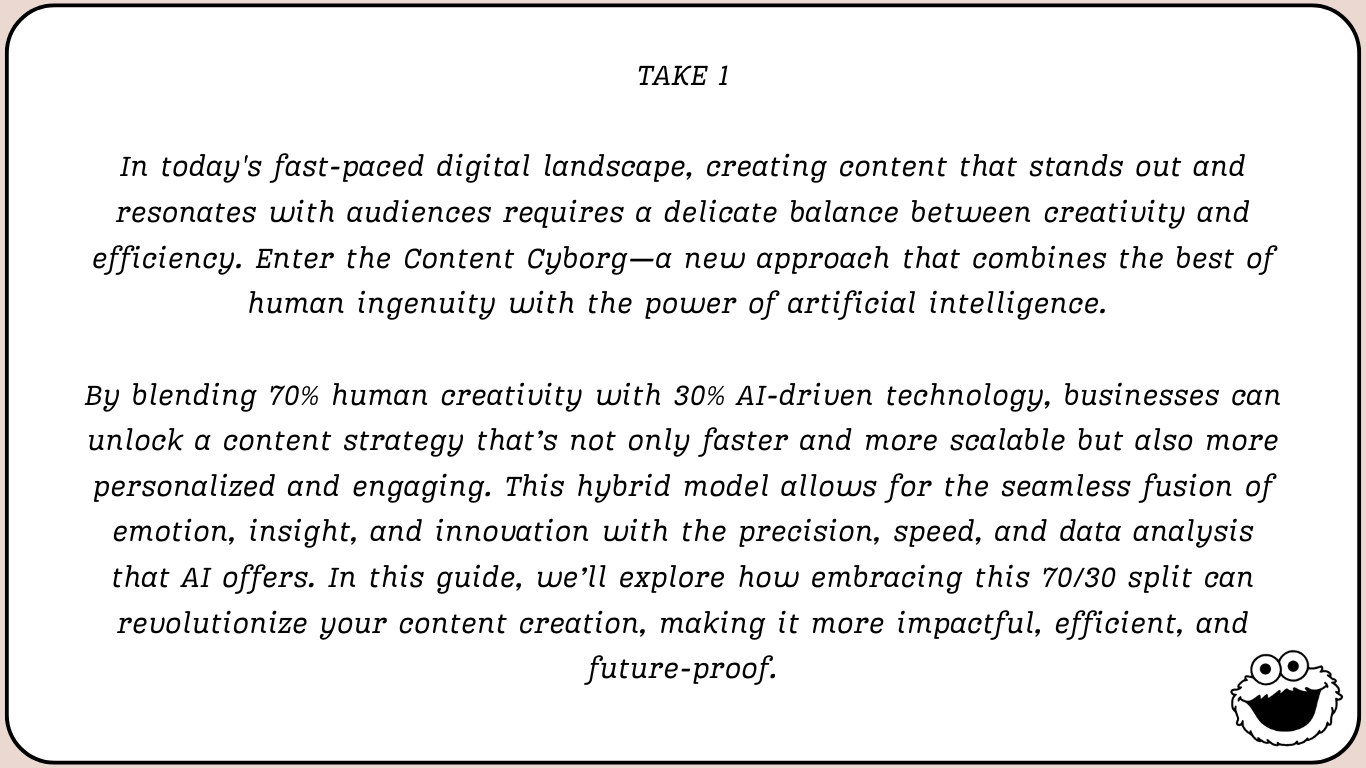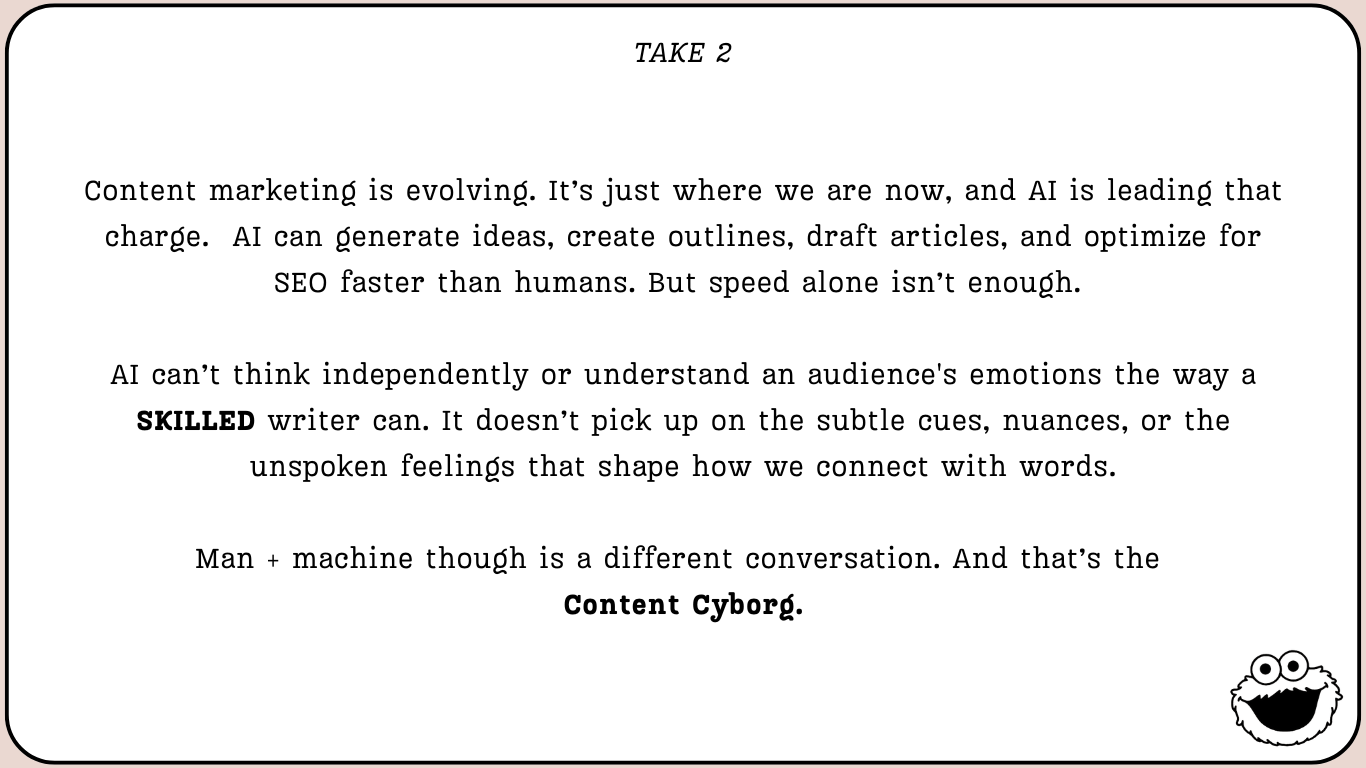
Let’s play a little game.
We’ve got two introductions for you. One is fully written with AI and the other uses the content cyborg approach. Can you spot the difference?


What’s your verdict? Take 1 or 2.
The first introduction was pure AI, and let’s be honest if you’ve used tools like Copy.ai, Gemini, or ChatGPT, you can probably tell. It’s structured, it’s clear, but did it truly connect with you? It ticks the right boxes but lacks depth, originality, and the human spark.
The Content Cyborg approach combines the best of both worlds. It uses AI to speed things up while still relying on human creativity to make your content sharper, more interesting, and hard to overlook.
Here’s why this blend should be your go-to strategy.
The rise of generative AI has split the content world into two camps
Those who rely entirely on AI and those who refuse to use it at all. But neither extreme is the answer.
AI can write, but can it write well?
Not always. AI-generated content suffers from a few glaring weaknesses:
It’s generic
AI models are trained on vast amounts of data. Meaning, their output often sounds like everything else on the internet. It’s predictable, much like how Barney Stinson can spot a woman who’s just ‘another one’ in a crowd (yeah, I just had to. I’m crazy about movie references).
AI also remixes existing ideas. It can’t generate fresh insights or personal experiences. It doesn’t break new ground; it repackages the old.
And yeah, that sentence above was all AI. See? Sounds off if you ask me.

Search engines favor originality and authority.
Flooding the internet with AI-generated content may work in the short term, but long term? It’s a race to the bottom.
Search engines are designed to reward high-quality, original content that helps users.
When you rely too much on AI, you’re essentially spamming the web with cookie-cutter content that doesn’t add real value.
Eventually, this tanks your rankings because Google’s algorithms can spot low-quality content quickly.
AI can generate text, but it doesn’t feel.
It can’t tap into human emotions or convey the depth of a personal story.
Unlike AI, human writers can infuse content with emotional intelligence, creating connections through understanding and empathy.
Storytelling is more than just stringing words together; it requires an understanding of context, tone, and the subtle nuances that make a story resonate.
AI may be able to mimic structure, but it cannot capture the emotional depth and nuance that makes storytelling truly compelling.
Human-only content is no better
Creating high-quality content from scratch takes time—tons of it. You’re talking about structuring, drafting, revising, and then going over it all again to make sure it’s perfect.
And while businesses need content at scale to stay competitive, human writers simply have their limits.
Unlike AI, which can churn out thousands of words in minutes, a human writer can’t pump out 10,000 words before lunch without sacrificing quality.
The reality is that human-only content creation demands a lot more resources. This means slower production, higher costs, and a lot more effort to keep up with the content needs of your business.
Then there’s the Content Cyborg Approach (part human, part AI)
AI speeds up idea generation, first drafts, etc. Humans refine the message, add creativity, and inject originality. AI organizes the info, humans bring depth and strategic insight.
This is the future of content. Where AI falls short, human expertise takes over. Where humans slow down, AI accelerates.
The result is faster, smarter, more effective content that outperforms both AI-only and human-only content.
Using the Cyborg Approach in Content Marketing
While AI is a powerful tool, it’s far from perfect.
Fact-Checking & Accuracy
AI can be fast, but accuracy is another matter. It relies on patterns and historical information to generate content. This leaves room for error, especially when it comes to ensuring factual accuracy.
So, I double-check the facts myself, and these three questions usually help me spot any flaws in AI-generated content:
- Does the information match the consensus within the field?
- Could the facts be misleading in the way they're presented?
- Can you trace the facts back to their original source?
This oversight guarantees the content’s credibility and accuracy.
Brand Voice & Authenticity
Every brand has a unique voice—a personality that AI struggles to replicate.
While AI can generate content based on parameters, it cannot consistently reflect a brand’s tone and message across all materials.
Humans know how to truly engage with an audience, speak to their needs, and foster real connections.
AI is undoubtedly an invaluable asset in content creation, but it is the human touch that keeps content grounded, emotionally resonant, and aligned with the authentic voice of any brand.
But You Need the Right AI Tools
Not all AI tools are created equal, and the right one = better execution. Here are a few of the best tools and when you’d probably need them:
1. OpenAI’s ChatGPT (and GPT-based tools)
- Best for: Idea generation, drafting, rewriting, and content expansion.
- Use it when:
- You need help brainstorming ideas or outlines.
- You’re looking to draft content quickly or expand on a short paragraph.
- You want to refine existing content or add more detail without starting from scratch.
- You need quick responses to basic questions or explanations on a topic.
2. Jasper (formerly Jarvis)
- Best for: Blog posts, social media content, and email marketing copy.
- Use it when:
- You need to generate long-form content, like articles or blogs, in a short amount of time.
- You're creating persuasive sales copy, email subject lines, or social media posts that need to engage readers immediately.
- You need variations of content for A/B testing.
3. Copy.ai
- Best for: Marketing copy, headlines, product descriptions, and ad copy.
- Use it when:
- You need quick, catchy marketing content for ads, landing pages, or email campaigns.
- You want a fresh take on your existing content or need to generate multiple headlines for testing.
4. Grammarly
- Best for: Grammar, spelling, style checks, and tone adjustments.
- Use it when:
- You want to proofread your content for grammatical errors, awkward phrasing, or style issues.
- You need help improving the clarity, conciseness, and tone of your writing.
- You're aiming to ensure your content is professional and error-free before publication.
Don’t kill the 70% human

Relying too much on AI can make your content feel flat, generic, and lifeless. Sure, AI is fast and convenient, but if you let it do all the work, you’ll end up with content that sounds the same as everyone else’s.
So, experiment with AI. Test it, refine it, and integrate it into your workflow. But also keep humans in charge, and your content will always feel authentic.
The best content writing approach is a cyborg: part technology, part creativity, and all heart.
